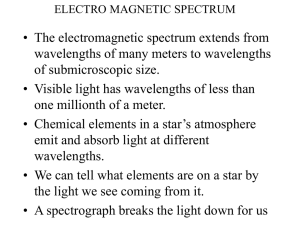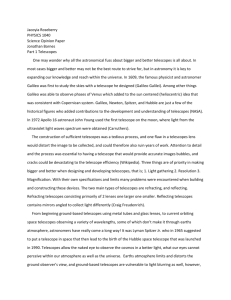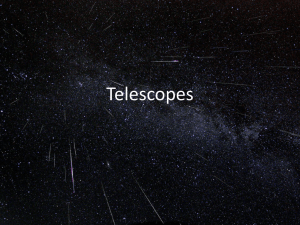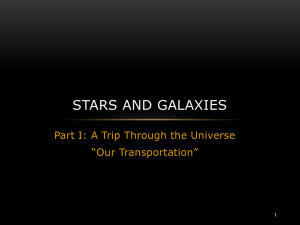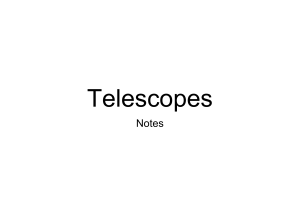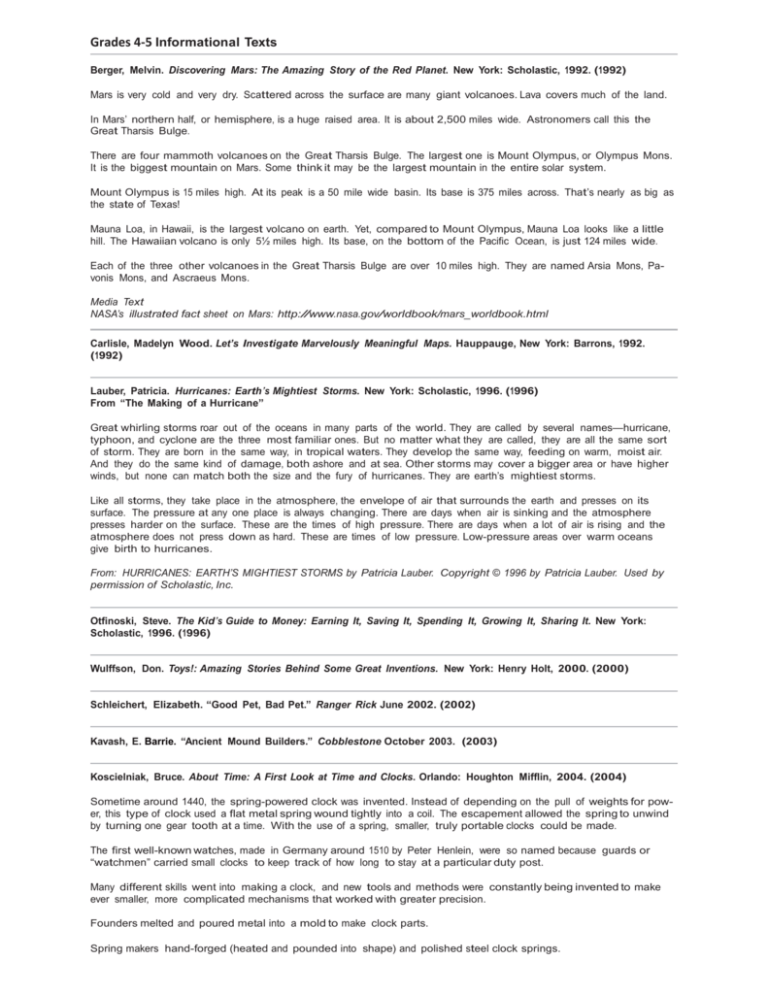
Grades 4-5 Informational Texts
Berger, Melvin. Discovering Mars: The Amazing Story of the Red Planet. New York: Scholastic, 1992. (1992)
Mars is very cold and very dry. Scattered across the surface are many giant volcanoes. Lava covers much of the land.
In Mars’ northern half, or hemisphere, is a huge raised area. It is about 2,500 miles wide. Astronomers call this the
Great Tharsis Bulge.
There are four mammoth volcanoes on the Great Tharsis Bulge. The largest one is Mount Olympus, or Olympus Mons.
It is the biggest mountain on Mars. Some think it may be the largest mountain in the entire solar system.
Mount Olympus is 15 miles high. At its peak is a 50 mile wide basin. Its base is 375 miles across. That’s nearly as big as
the state of Texas!
Mauna Loa, in Hawaii, is the largest volcano on earth. Yet, compared to Mount Olympus, Mauna Loa looks like a little
hill. The Hawaiian volcano is only 5½ miles high. Its base, on the bottom of the Pacific Ocean, is just 124 miles wide.
Each of the three other volcanoes in the Great Tharsis Bulge are over 10 miles high. They are named Arsia Mons, Pavonis Mons, and Ascraeus Mons.
Media Text
NASA’s illustrated fact sheet on Mars: http://www.nasa.gov/worldbook/mars_worldbook.html
Carlisle, Madelyn Wood. Let’s Investigate Marvelously Meaningful Maps. Hauppauge, New York: Barrons, 1992.
(1992)
Lauber, Patricia. Hurricanes: Earth’s Mightiest Storms. New York: Scholastic, 1996. (1996)
From “The Making of a Hurricane”
Great whirling storms roar out of the oceans in many parts of the world. They are called by several names—hurricane,
typhoon, and cyclone are the three most familiar ones. But no matter what they are called, they are all the same sort
of storm. They are born in the same way, in tropical waters. They develop the same way, feeding on warm, moist air.
And they do the same kind of damage, both ashore and at sea. Other storms may cover a bigger area or have higher
winds, but none can match both the size and the fury of hurricanes. They are earth’s mightiest storms.
Like all storms, they take place in the atmosphere, the envelope of air that surrounds the earth and presses on its
surface. The pressure at any one place is always changing. There are days when air is sinking and the atmosphere
presses harder on the surface. These are the times of high pressure. There are days when a lot of air is rising and the
atmosphere does not press down as hard. These are times of low pressure. Low-pressure areas over warm oceans
give birth to hurricanes.
From: HURRICANES: EARTH’S MIGHTIEST STORMS by Patricia Lauber. Copyright © 1996 by Patricia Lauber. Used by
permission of Scholastic, Inc.
Otfinoski, Steve. The Kid’s Guide to Money: Earning It, Saving It, Spending It, Growing It, Sharing It. New York:
Scholastic, 1996. (1996)
Wulffson, Don. Toys!: Amazing Stories Behind Some Great Inventions. New York: Henry Holt, 2000. (2000)
Schleichert, Elizabeth. “Good Pet, Bad Pet.” Ranger Rick June 2002. (2002)
Kavash, E. Barrie. “Ancient Mound Builders.” Cobblestone October 2003. (2003)
Koscielniak, Bruce. About Time: A First Look at Time and Clocks. Orlando: Houghton Mifflin, 2004. (2004)
Sometime around 1440, the spring-powered clock was invented. Instead of depending on the pull of weights for power, this type of clock used a flat metal spring wound tightly into a coil. The escapement allowed the spring to unwind
by turning one gear tooth at a time. With the use of a spring, smaller, truly portable clocks could be made.
The first well-known watches, made in Germany around 1510 by Peter Henlein, were so named because guards or
“watchmen” carried small clocks to keep track of how long to stay at a particular duty post.
Many different skills went into making a clock, and new tools and methods were constantly being invented to make
ever smaller, more complicated mechanisms that worked with greater precision.
Founders melted and poured metal into a mold to make clock parts.
Spring makers hand-forged (heated and pounded into shape) and polished steel clock springs.
Screw makers cut screws used to fasten clocks together by using a small lathe devised by a German clockmaker in
1480. Earlier, only wedges or pegs were used.
Gear-tooth cutting had been done by hand until the mid-1500s, when Giannelo Torriano of Cremona, Italy, invented a
machine that could cut perfect gear teeth. Brass replaced iron for clock making.
Engravers, gilders, and enamellers decorated clock cases and dials.
Glass -making shops made and cut glass.
Woodworkers made clock cases.
Excerpt from ABOUT TIME: A First Look at Time and Clocks by Bruce Koscielniak. Copyright © 2004 by Bruce Koscielniak. Used by permission of Houghton Mifflin Harcourt Publishing Company. All rights reserved.
Banting, Erinn. England the Land. New York: Crabtree, 2004. (2004)
From “Living Fences”
Low fences, some of which are thousands of years old, divide much of England’s countryside. These fences, called
hedgerows, were fist build by the Anglo-Saxons, a group of warriors from Germany and Scandinavia who arrived in
England around 410 A.D. As they gained control of sections of land, they protected their property with walls made
from wooden stakes and spiny plants. Dead hedgerows, as these fences were called, were eventually replaced by
fences made from live bushes and trees.
Recently, people building large farms and homes in the countryside have destroyed many live hedgerows. Other
people are working to save the hedgerows, which are home to a variety of wildlife, including birds, butterflies, hedgehogs, and hares.
Hakim, Joy. A History of US. Oxford: Oxford University Press, 2005. (2005)
From Book 1: The First Americans, Prehistory to 1600; Chapter 7: “The Show-Offs”
In case you forgot, you’re still in that time-and-space capsule, but you’re not a baby anymore. You’re 10 years old and
able to work the controls yourself. So get going; we want to head northwest, to the very edge of the land, to the region that will be the states of Washington and Oregon. The time? We were in the 13th century; let’s try the 14th century
for this visit.
Life is easy for the Indians here in the Northwest near the great ocean. They are affluent (AF-flew-ent –it means
“wealthy”) Americans. For them the world is bountiful: the rivers hold salmon and sturgeon; the ocean is full of seals,
whales, fish, and shellfish; the woods are swarming with game animals. And there are berries and nuts and wild roots
to be gathered. They are not farmers. They don’t need to farm.
Those Americans go to sea in giant canoes; some are 60 feet long. (How long is your bedroom? Your schoolroom?)
Using stone tools and fire, Indians of the Northwest cut down gigantic fir trees and hollow out the logs to make their
boats. The trees tower 200 feet and are 10 feet across at the base. There are so many of them, so close together, with
a tangle of undergrowth, that it is sometimes hard for hunters to get through the forest. Tall as these trees are, there
are not as big as the redwoods that grow in a vast forest to the south (in the land that will become California).
Media Text
“American Indians of the Pacific Northwest Collection,” a digital archive of images and documents hosted by the University of Washington: http://content.lib.washington.edu/aipnw/
Ruurs, Margriet. My Librarian Is a Camel: How Books Are Brought to Children Around the World. Honesdale, Penn.:
Boyds Mills Press, 2005. (2005)
From “Peru”
Children in Peru can receive their book in several different, innovative ways.
CEDILI-IBBY Peru is an institution that delivers books in bags to families in Lima. Each bag contains twenty books,
which families can keep for a month. The books come in four different reading levels so that children really learn how
to read. This project in Spanish is called El Libro Compartido en Familia and enables parents to share the joy of books
with their children.
In small, rural communities, books are delivered in wooden suitcases and plastic bags. These suitcases and bags contain books that the community can keep and share for the next three months. The number of books in each suitcase
depends on the size of the community. There are no library buildings in these small towns, and people gather outside,
in the plaza, to see books they can check out. In the coastal regions, books are sometimes delivered by donkey cart.
The books are stored in the reading promoter’s home.
In the ancient city of Cajamarca, reading promoters from various rural areas select and receive a large collection of
books for their area. The program is called Aspaderuc. The reading promoter lends these books to his or her neighbors, and after three months, a new selection of books goes out to each area. Books in this system are for children
and adults.
And last but not least, Fe Y Alegria brings a collection of children’s books to rural schools. The books are brought
from school to school by wagon. The children, who are excited about browsing through the books when they arrive,
are turning into avid readers.
Simon, Seymour. Horses. New York: HarperCollins, 2006. (2006)
Horses move in four natural ways, called gaits or paces. They walk, trot, canter, and gallop. The walk is the slowest
gait and the gallop is the fastest.
When a horse walks, each hoof leaves the ground at a different time. It moves one hind leg first, and then the front
leg on the same side; then the other hind leg and the other front leg. When a horse walks, its body swings gently with
each stride.
When a horse trots, its legs move in pairs, left front leg with right hind leg, and right front leg with left hind leg. When
a horse canters, the hind legs and one front leg move together, and then the hind legs and the other foreleg move
together.
The gallop is like a much faster walk, where each hoof hits the ground one after another. When a horse gallops, all
four of its hooves may be flying off the ground at the same time.
Horses are usually described by their coat colors and by the white markings on their faces, bodies, legs, and hooves.
Brown horses range in color from dark brown bays and chestnuts to golden browns, such as palominos, and lighter
browns such as roans and duns.
Partly colored horses are called pintos or paints. Colorless, pure-white horses—albinos—are rare. Most horses that look
white are actually gray.
Skewbalds have brown-and-white patches. Piebalds have black and white patches. Spotteds have dark spots on a
white coat or white spots on a dark coat.
Used by permission of HarperCollins Publishers.
Montgomery, Sy. Quest for the Tree Kangaroo: An Expedition to the Cloud Forest of New Guinea. Orlando:
Houghton Mifflin, 2006. (2006)
From “Marsupial Mania”
Stuart Little, the small mouse with big parents, had nothing on baby marsupials. Marsupials (“mar-SOUP-ee-ulz”) are
special kinds of mammals. Even the biggest ones give birth to babies that are incredibly small. A two-hundred-pound
six-foot mother kangaroo, for instance, gives birth to a baby as small as a lima bean. That’s what makes marsupials
marsupials. Their babies are born so tiny that in order to survive they must live in a pouch on the mother’s tummy.
The pouch is called a marsupium. (Don’t you wish you had one?)
A baby marsupial lives hidden in the mother’s warm moist pouch for months. There it sucks milk from a nipple like
other baby mammals. One day it’s big enough to poke its head out to see the world. The European explorers who saw
kangaroos for the first time in Australia reported they had discovered a two-headed animal—with one head on the
neck and another in the belly.
North America has only one marsupial. You may have seen it: The Virginia opossum actually lives in most of the
United States, not just Virginia. South America also has marsupials. But most marsupials live in or near Australia. They
include the koala (which is not a bear), two species of wombat, the toothy black Tasmania devil, four species of black
and white spotted “native cats” (though they’re not cats at all), and many others.
The most famous marsupials, however, are the kangaroos. All kangaroos hop—some of them six feet high and faster
than forty miles an hour. More than fifty different species of kangaroo hop around on the ground—from the big red
kangaroo to the musky rat kangaroo.
Excerpt from QUEST FOR THE TREE KANGAROO: An Expedition to the Cloud Forest of New Guinea by Sy Montgomery. Text Copyright © 2006 by Sy Montgomery. Used by Permission of Houghton Mifflin Harcourt Publishing Company.
All rights reserved.
Simon, Seymour. Volcanoes. New York: HarperCollins, 2006. (2006)
In early times, no one knew how volcanoes formed or why they spouted red-hot molten rock. In modern times, scientists began to study volcanoes. They still don’t know all the answers, but they know much about how a volcano works.
Our planet is made up of many layers of rock. The top layers of solid rock are called the crust. Deep beneath the crust
is the mantle, where it is so hot that some rock melts. The melted, or molten, rock is called magma.
Volcanoes are formed when magma pushes its way up through the crack in Earth’s crust. This is called a volcanic
eruption. When magma pours forth on the surface, it is called lava.
Text Copyright © 1998 by Seymour Simon. Used by permission of HarperCollins Publishers.
Nelson, Kadir. We Are the Ship: The Story of Negro League Baseball. New York: Jump at the Sun, 2008. (2008)
From “4th Inning: Racket Ball: Negro League Owners”
Most of the owners didn’t make much money from their teams. Baseball was just a hobby for them, a way to make
their illegal money look good. To save money, each team would only carry fifteen or sixteen players. The major league
teams each carried about twenty-five. Average salary for each player started at roughly $125 per month back in ‘34,
and went up to $500-$800 during the forties, though there were some who made much more than that, like Satchel
Paige and Josh Gibson. The average major league player’s salary back then was $7,000 per month. We also got
around fifty cents to a dollar per day for food allowance. Back then you could get a decent meal for about twenty-five
cents to seventy-five cents.
Some of the owners didn’t treat their players very well. Didn’t pay them enough or on time. That’s why we would
jump from team to team. Other owners would offer us more money, and we would leave our teams and go play for
them. We were some of the first unrestricted free agents.
There were, however, a few owners who did know how to treat their ballplayers. Cum Posey was one of them. He
always took care of his ballplayers, put them in the best hotels, and paid them well and on time. Buck Leonard said
Posey never missed a payday in the seventeen years he played for the Grays.
Cutler, Nellie Gonzalez. “Kenya’s Long Dry Season.” Time for Kids September 25, 2009. (2009)
Hall, Leslie. “Seeing Eye to Eye.” National Geographic Explorer September 2009. (2009)
A hungry falcon soars high above Earth. Its sharp eyes scan the ground. Suddenly, it spies something moving in the
grass. The falcon dives toward it.
Far below, a gray field mouse scurries through the grass. Its dark, beady eyes search constantly for danger. With eyes
on either side of its head, the mouse can see almost everything around it.
Will the mouse see the falcon in time to escape? Or, will the speedy falcon catch the prey it spied from far above?
Whatever happens, one thing is clear: Without eyes, neither animal has a good chance.
Why? Eyes help many animals make sense of the world around them - and survive. Eyes can guide the falcon to dinner or help the mouse see a perfect place to hide.
Animal eyes come in many different shapes, sizes, colors, and even numbers. Yet they do the same job. They all catch
light. With help from the brain, eyes turn light into sight.
Eyes work in the same way for people. Look at this page. You may think you see words and pictures. Believe it or not,
you don’t. All you see is light bouncing off the page. How is this possible? The secret is in the rules of light.
Light Rules
Light is a form of energy, like heat or sound. It can come from a natural source, like the sun, or artificial sources, like a
lamp or a flashlight.
Light is the fastest known thing. It travels in waves and in nearly straight lines. In air, it can speed 299,700 kilometers
(186,200 miles) per second. It can race from the sun to Earth in just over eight minutes! Light doesn’t always travel so
fast. For example, water or glass can slow light down, but just a bit.
Light may seem to break all driving speed laws. Yet there are certain rules it always follows. Light reflects, or bounces
off objects. It also refracts, or bends. And it can be absorbed, or soaked up, by objects. These rules of light affect
what, and how, we see.
Light! Eyes!
Imagine this scene: You’re at your desk happily reading Explorer magazine. Light from your desk lamp scatters in all
directions.
Light hits the page. Some bounces off the page, or reflects. It changes direction. It’s a little like how sound bounces
off a wall. Now some of this reflected light is traveling right toward your face. Don’t duck! For you to see Explorer,
some of this light has to enter your eyes. Objects become visible when light bounces off them.
Your eyes are light catchers. Yet it takes more than catching light to see an image. Your eyes also have to bend light.
Here’s how.
First, light hits your cornea. That’s the clear covering on the front of your eyeball. The cornea refracts, or bends, light.
And Action!
Is your cornea super strong? No! Think about how light travels more slowly through water. The same thing happens in
your cornea. As light passes through the cornea, it slows down. That makes the light change direction, or bend.
Next, light enters your pupil, the dark center part of your eye. It passes through your lens. The lens bends light, too.
What’s the big deal about bending light? That’s how your eyes focus, or aim the light to make a clear image.
The image appears on your retina at the back of your eyeball. It’s like a movie. Playing Today at a Theater in Your Eye:
Explorer magazine! There’s only one problem. The image is upside down. Luckily, your brain flips the image right side
up. That’s pretty smart!
Copyright © 2009 National Geographic. Used by permission.
Ronan, Colin A. “Telescopes.” The New Book of Knowledge. New York: Scholastic, 2010. (2010)
You can see planets, stars, and other objects in space just by looking up on a clear night. But to really see them--to
observe the craters on the moon, the rings around Saturn, and the countless other wonders in our sky--you must use
a telescope.
A telescope is an instrument used to produce magnified (enlarged) images of distant objects. It does this by gathering and focusing the light or other forms of electromagnetic radiation emitted or reflected by those objects. The word
“telescope” comes from two Greek words meaning “far” and “see.”
Kinds of Telescopes
There are many different types of telescopes, both optical and non-optical. Optical telescopes are designed to focus
visible light. Non-optical telescopes are designed to detect kinds of electromagnetic radiation that are invisible to
the human eye. These include radio waves, infrared radiation, X rays, ultraviolet radiation, and gamma rays. The word
“optical” means “making use of light.”
Some telescopes are launched into space. These telescopes gain clearer views. And they can collect forms of electromagnetic radiation that are absorbed by the Earth’s atmosphere and do not reach the ground.
Optical Telescopes
Different types of optical telescopes gather and focus light in different ways. Refracting telescopes, or refractors, use
lenses. Reflecting telescopes, or reflectors, use mirrors. And catadioptric telescopes, or catadioptrics, use a combination of lenses and mirrors. The main lens or mirror in an optical telescope is called the objective.
Refracting Telescopes. A refracting telescope is typically a long, tube-shaped instrument. The objective is a system
of lenses at the front end of the tube (the end facing the sky). When light strikes the lenses, it is bent and brought to a
focus within the tube. This forms an image of a distant object. This image can be magnified by the eyepiece. This
consists of a group of small lenses at the back of the tube. A camera can replace or be added to the eyepiece. Then
photographs can be taken of celestial objects. For many years, these cameras used film. Today most are equipped
with charge-coupled devices (CCD’s). These devices use semiconductor chips to electronically capture images. CCD’s
are similar to the devices in home digital cameras and video camcorders. However, the CCD’s used by astronomers
are usually extremely sensitive to light.
From Ronan, Colin A. “Telescopes.” Reviewed by William A. Gutsch. The New Book of Knowledge®. Copyright © 2010.
Grolier Online. All rights reserved. Reprinted by permission of Scholastic Inc.
Buckmaster, Henrietta. “Underground Railroad.” The New Book of Knowledge. New York: Scholastic, 2010. (2010)




